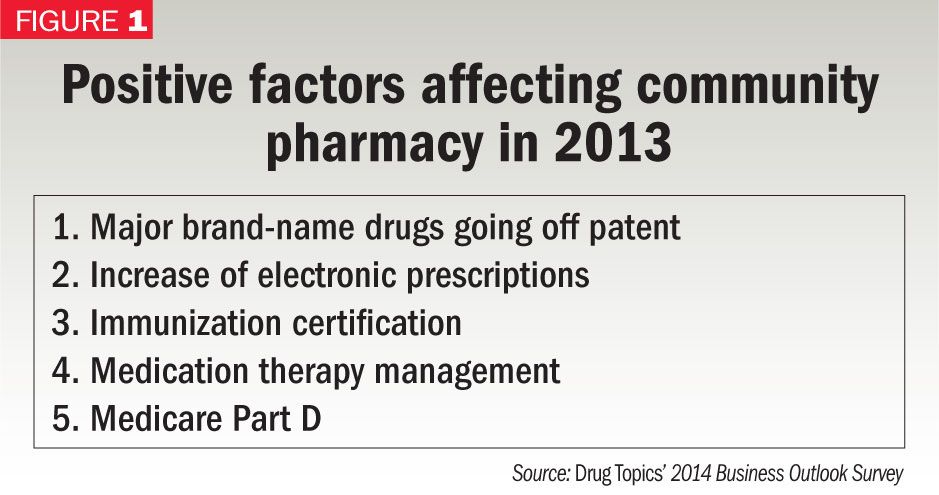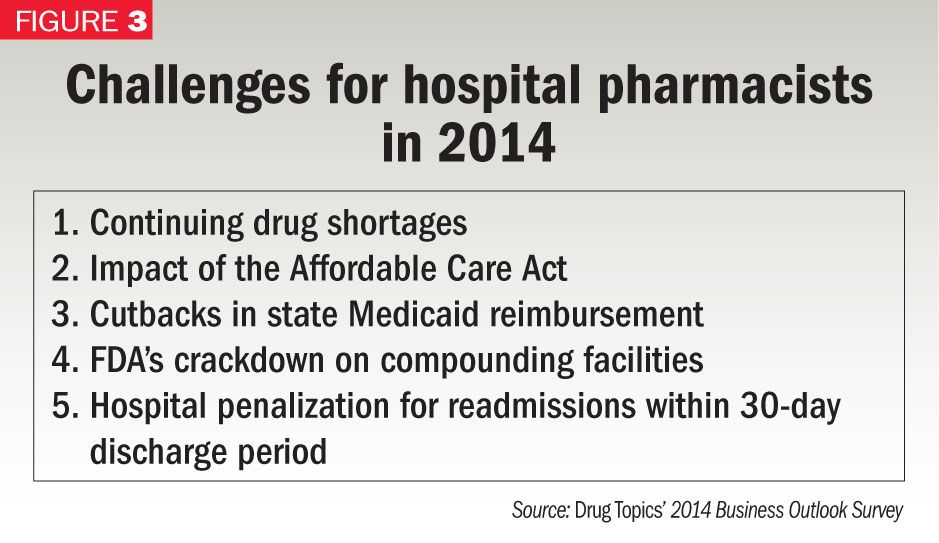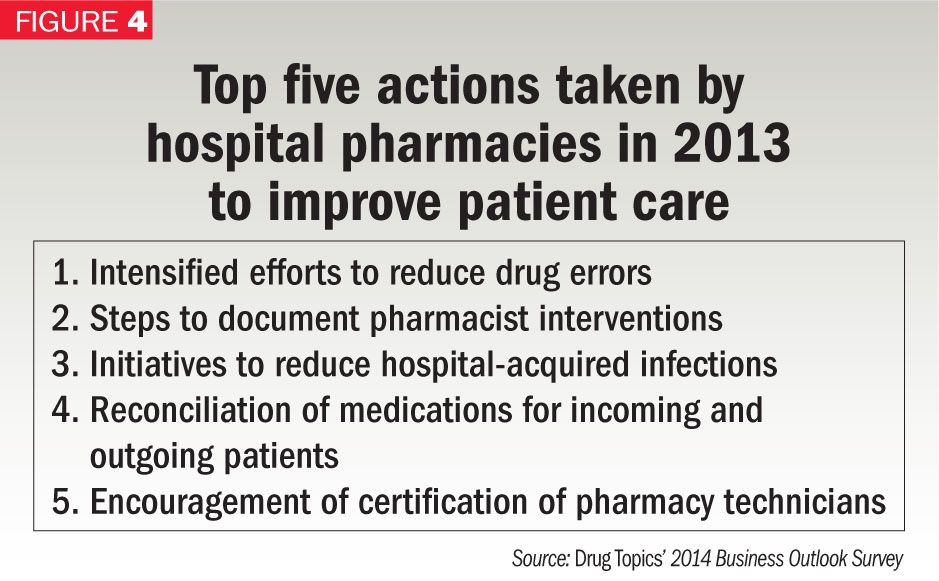Pharmacists face tougher 2014
Shrinking margins, drug shortages, ACA pose challenges for community, hospital pharmacists.
Pharmacists in the community setting (64%) anticipate a slightly tougher business climate next year, with retail sales remaining the same or increasing, compared to 2013 estimates (66%). However, estimates of net profits in the community pharmacy setting in 2014 are on par with those of 2013, with approximately half of those surveyed expecting net profits to remain the same or increase, according to respondents to Drug Topics 2014 Business Outlook Survey.
Expectations for hospital pharmacy have dropped slightly. Last year 70% of respondents expressed a positive outlook; this year, 67% expect the pharmacy department to reach the financial goals of their hospital in contributions to its net revenues.
These were some of the findings from Drug Topics’ 2014 Business Outlook Survey, an annual survey of more than 600 community pharmacists and approximately 300 hospital pharmacists that examines the current business climate and future prospects. This year’s survey was fielded for two weeks in November 2013.
Community pharmacists

Community pharmacists (n=639) ranked the top five factors that contributed positively to their businesses last year as follows (Figure 1):
1. Major brand-name drugs going off patent
2. Increase of electronic prescriptions
3. Immunization certification
4. Medication therapy management
5. Medicare Part D
Compared with last year’s survey answers, responses showed little difference, except that this year MTM made the list and Medicare Part D edged out healthcare reform.

The biggest challenges that community pharmacists listed for 2014, outlined in Figure 2, were:
1. Competition from mail-order pharmacies
2. Healthcare reform
3. Decrease in state Medicaid rates and MAC and FUL,
4. Preferred pharmacy networks for Medicare Part D
5. PBM practices
Impact of Medicare Part D
When Medicare Part D was implemented in 2006, it was considered a good program for seniors and pharmacies alike. At the time, seniors thought that they no longer had to worry about obtaining medications at an affordable rate when they used generic drugs. Community pharmacies saw increased business.
Now, however, Medicare beneficiaries are enrolling in plans with preferred pharmacy networks/mail-order pharmacies, and this has had a negative impact on some community pharmacies, according to respondents to Drug Topics survey.
“Reimbursement does not keep up with increased drug cost. Medicare Part D cuts into more favorable reimbursement from state Medicaid. Reduced MAC levels and increases in number of Rxs have occurred. It is very time-consuming. Bookkeeping, billing, and record keeping are a nightmare,” several readers responded.
“Medicare Part D is a horrible plan, both for seniors and pharmacies. However, it is a wonderful plan for the insurance companies who were allowed to write the law for Medicare Part D,” a retail pharmacist said.
“For 2014, I cannot enroll in any network and be considered a ‘preferred’ pharmacy. I’ve already received dozens of greeting cards of regret from patients who will not be able to use my pharmacy next year,” reported one community pharmacist.
Helping seniors
Some survey respondents did note that Medicare Part D has helped seniors fill their prescriptions consistently, because the drugs are more affordable with this government subsidy. Medicare beneficiaries with Medicare Part D coverage have greater access to pharmacies, consultations with pharmacists, and medication therapy management (MTM).
Other pharmacists responded that increased sales and drug coverage have increased business, but resulted in lower net profit for pharmacies. In addition, the dual eligibles, those eligible for state Medicaid and Medicare, have had an impact on business, with much lower dispensing fees resulting when Medicaid beneficiaries were switched to Medicare.
Another problem with Medicare Part D plans occurs when seniors switch plans, said one survey respondent. “Each plan operates its own fee schedule and step therapy requirements. When patients change from one plan to another, step therapies must be redone, which wastes time and resources, not to mention affecting the patient, who doesn’t get proper treatment.”
However, one pharmacist from a chain pharmacy noted that being a preferred pharmacy chain has been positive. “We are able to provide competitive prices and provide patients a cost-saving advantage, serving a large population of patients on Medicare Part D. “
Another community pharmacist noted the pros and cons. “The positive aspects are that prescription healthcare is available for seniors, most generics are cheap, and immunizations are covered at the pharmacy. The negatives are two major loopholes - the donut hole and changing formularies once patients sign up. Also, the customer service on insurance cards is a joke. Patients cannot change plans but once a year, even after finding out that they were misrepresented after signing.”
MTM services
About the same percentage of pharmacies (43%) as in 2012 offered MTM services in 2013 under Medicare Part D. Unfortunately, only 25% of the 626 respondents are being paid for these services. Of these, the majority of pharmacists delivering MTM (45%) received between $0 and $249 for these services. Thirty-one percent reported payments between $250 to $999, 20% reported payments between $1,000 to $4,999, and 5% reported $5,000 and above.
Some were concerned about their ability to deliver MTM services. One respondent noted, “We need restructuring in the retail setting in order to make MTM and immunizations work efficiently.”
Frustrations in retail pharmacy
When asked whether they were satisfied with the way their pharmacy associations have represented them in 2013, 35% responded no, 34% responded yes, and 31% said they didn’t know.
A number of state associations were lauded for their leadership in formulating national policies. “The Arkansas Pharmacist Association is one of the leaders in the questioning and formulating of national policies. The association places the patient first and shows that the PBMs are killing business and government that offer Rx programs by their greed.”
A survey respondent from Pennsylvania was pleased with the state association. “The Pennsylvania Pharmacist Association has an excellent CEO who has accomplished a great deal during her tenure, both within the profession and with her relationship with state government.”
Others thanked the national pharmacy associations. “The American Pharmacists Association collaboration with the American Society of Health-System Pharmacists and the National Community Pharmacists Association are empowering pharmacists as healthcare providers. State associations’ effectiveness hinges on national groups.”
A California pharmacist was pleased with the California Pharmacists Association because “the association did everything it could to get pharmacists recognized as providers. We were successful. Hopefully, it can become a nationwide policy.”
One respondent from Michigan was dissatisfied with the state association, citing stress and workload. “I have worked in retail pharmacy for 33 years and I burned out because of no help. The state association has done nothing to mandate a manageable pharmacist-to-tech ratio. I am very disheartened about retail pharmacy because I used to really enjoy it and took pride in my profession. These [working conditions] put the public at risk, with many mistakes occurring when a pharmacist has low or no staff.”
Other community pharmacists are also saddened by working conditions. “After years of disappointment, I no longer follow what [the associations] do. They seek [provider] status while working conditions have worsened for retail pharmacists,” said one survey respondent. “Extensive lowering of tech help hours is putting a lot of undue pressure on pharmacists. No association seems to be concerned with deterioration of workplace conditions for retail chain pharmacists,” another pharmacist said.
Hospital pharmacists
Approximately 67% of the hospital pharmacists (n=298) reported in the survey that the business climate was good to excellent, as it related to their expectation of reaching their financial goals for the year. This was slightly lower than expectations expressed in 2012, with approximately 70% optimistic about that year. Almost two-thirds expected to stay within budget for 2013, compared to approximately 72% last year.
Next year, 41% of hospital pharmacists expect their 2014 drug budget to increase, on par with last year. However, almost 15% expect the 2014 drug budget to decrease, compared to 12% last year. Approximately 35% expect the 2014 drug budget to remain the same, compared to 43% last year.
In terms of 2014 salaries for hospital pharmacists, only 22% expect salaries to increase, whereas 62% expect them to remain the same, and 11% expect a decrease in compensation. Last year, approximately 30% expected pharmacist salaries in the hospital setting to increase, according to last year’s survey results.
In terms of 2014 pharmacy technician salaries, only 31% expect increases, 60% expect the salaries to remain the same, and 4% expect them to decline. In last year’s survey, 34% of the survey respondents expected pharmacy technician to increase, 58% expected them to remain the same, and 2% expected declines.
Hospital pharmacists are also bracing for possible layoffs in 2014. Almost 18% expected the number of pharmacists in their department to decrease next year, compared with only 10% who expected decreases in 2013. However, approximately 15% expect increases in pharmacist staffing in their department in 2014, compared to only 12% who expected pharmacist staffing to climb last year.
According to 24% of survey respondents, pharmacy technician staffing numbers are also expected to climb in 2014. About 64% expect pharmacy tech levels to remain the same in 2014, and 8% expect them to decline.
Improving patient care

Some of the big concerns on the minds of hospital pharmacists include continuing drug shortages, the impact of the Affordable Care Act, cutbacks in state Medicaid reimbursement, FDA’s crackdown on compounding facilities, and penalization of hospitals for readmissions within the 30-day discharge period (Figure 3).

The top five actions that hospital pharmacies took in 2013 to improve patient care (Figure 4) were:
1. Increased efforts to reduce drug errors
2. Steps to document pharmacist interventions
3. Taken action to reduce hospital-acquired infections
4. Reconciled medications for incoming and outgoing patients
5. Encouraged pharmacy technicians to become certified
The top five actions that hospital pharmacies are expected to perform in 2014 to improve patient care (Figure 4) are the same as last year, except that reconciled medications moves up to third place and actions to reduce hospital-acquired infections moves to fourth place.
Satisfaction with associations
Approximately 40% of hospital pharmacists surveyed said they were satisfied with the pharmacy associations, up from only 35% last year. Some pharmacists stated that they were pleased with the work of the American Society of Health-System Pharmacists (ASHP), because the society is fighting for the role of pharmacists in delivering healthcare and is an excellent resource for drug shortages.
“ASHP works well with the FDA and Congress to help refine legislation to improve regulatory requirements,” noted one hospital pharmacist. “ASHP and CSHP have been very active and vocal in events and legislation around the new compounding law and obtaining provider status for pharmacists,” said another.
Some respondents worried about the number of new pharmacy graduates, leading to an oversupply of pharmacists. “Organizations have not addressed the oversupply [of pharmacists]. This should have been addressed 5+ years ago,” said one pharmacist. “With cutbacks we encountered this year, I did not see any assistance from our organizations,” another pharmacist said.
Another pharmacist said that advocacy for provider status was necessary. “Bottom line is we need provider status. Without this, pharmacy cannot be recognized or participate on a meaningful level in patient care,” a survey respondent said.